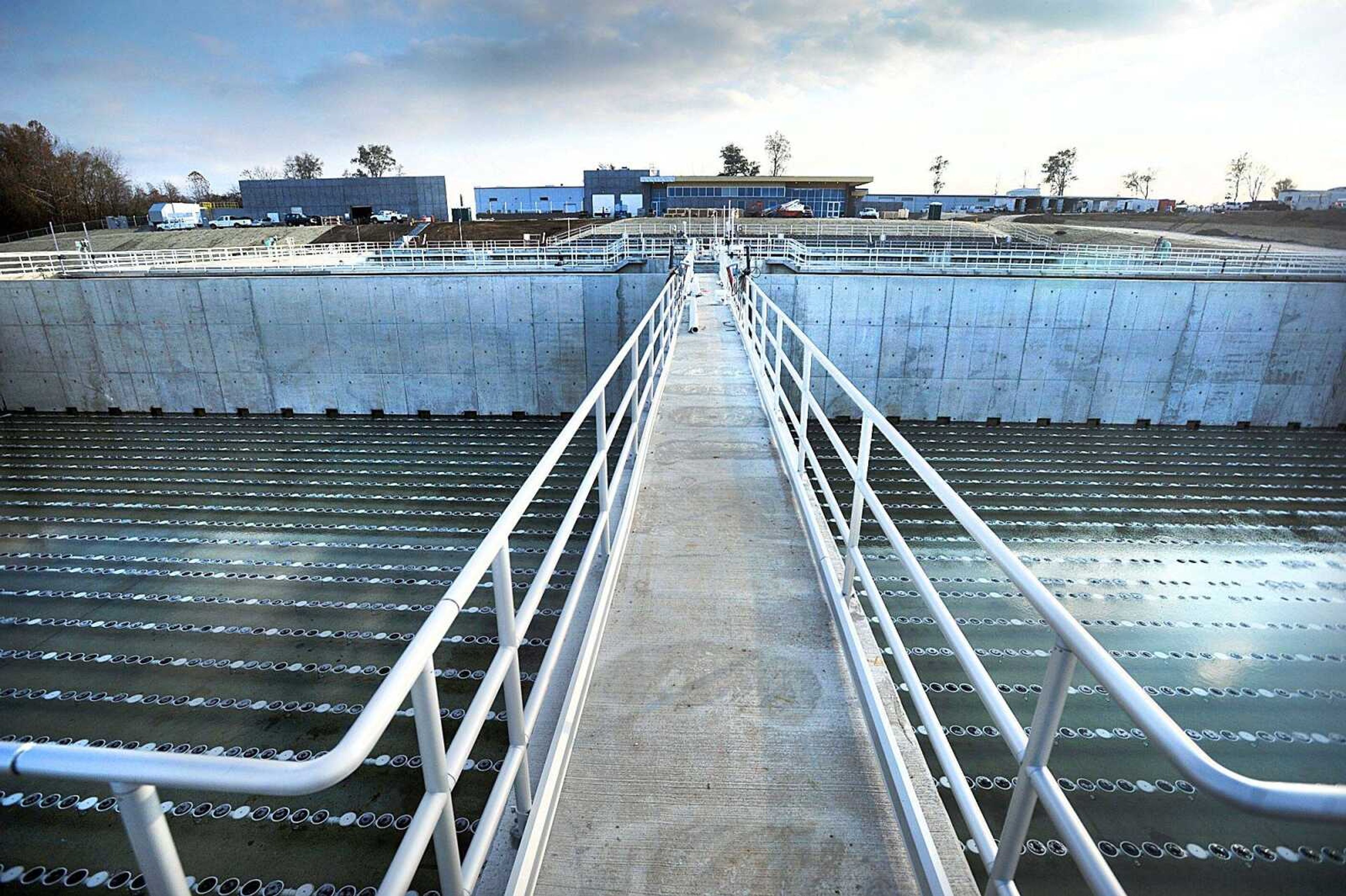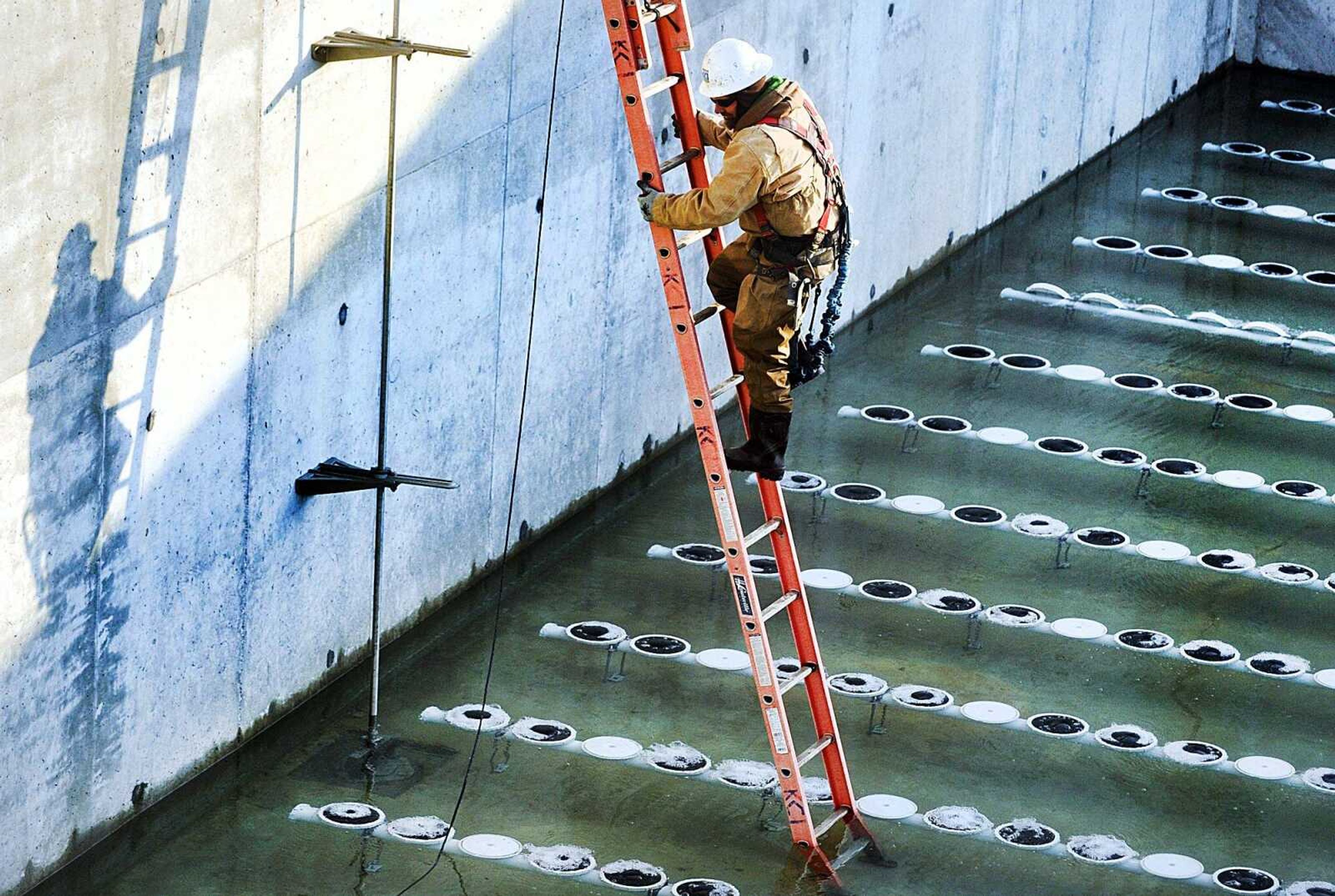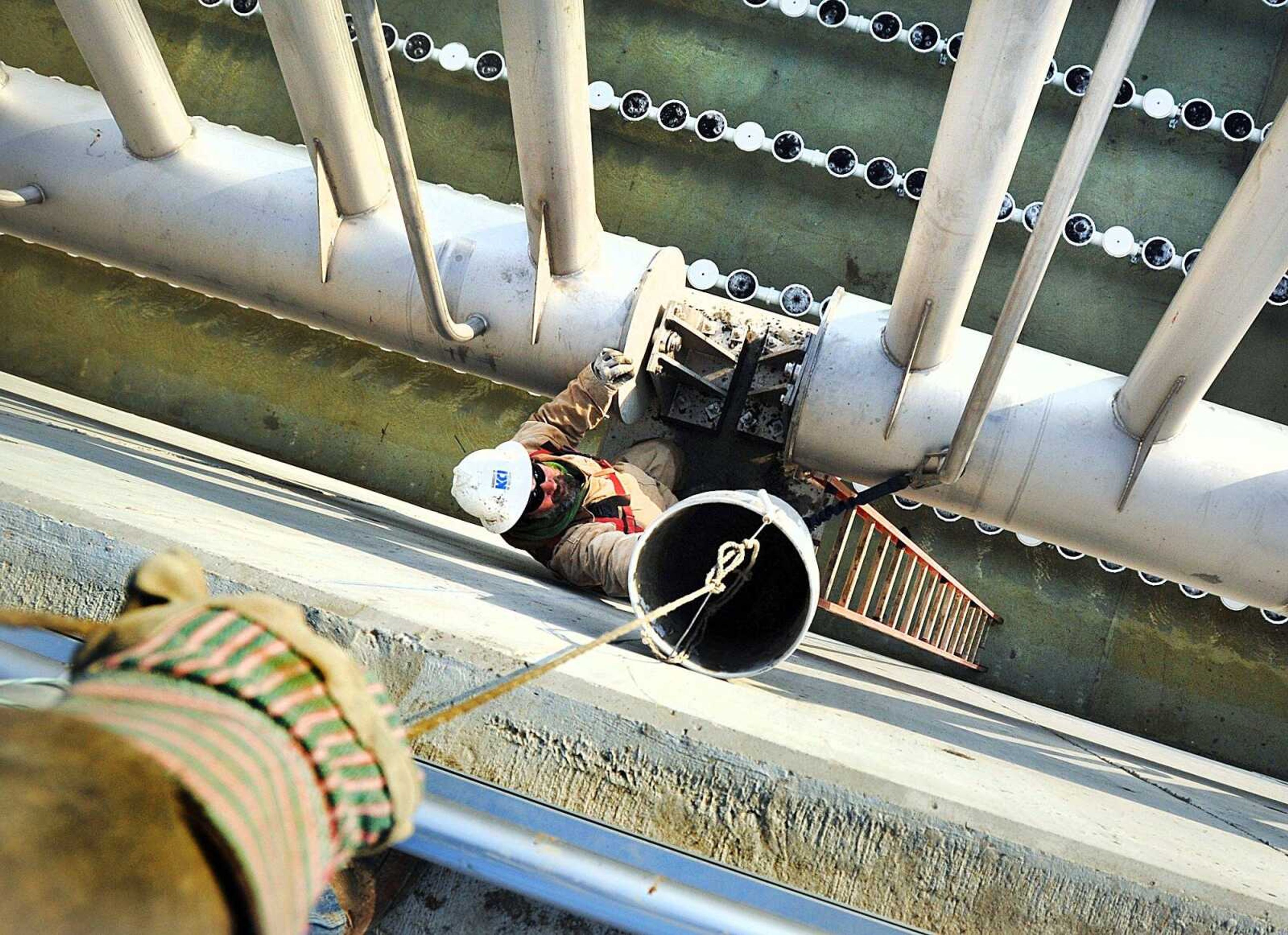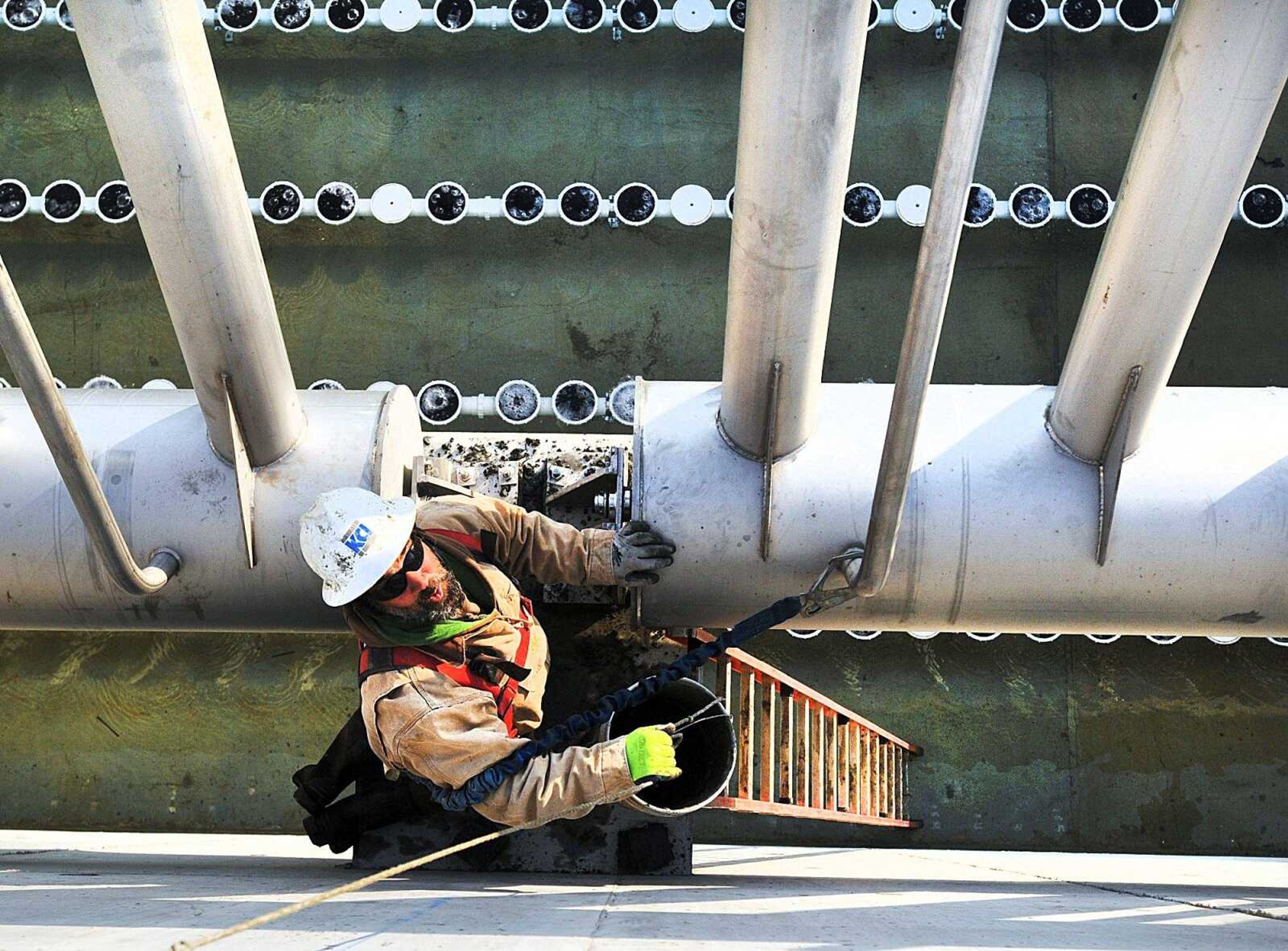Cape Girardeau's largest capital improvement project is inching closer to another milestone.

Water soon will be diverted to the new wastewater treatment facility on Corporate Circle, near the city's public works station. The process was expected to begin this week, but recent estimates by the contractors pushed the date back by at least one week.
The $55 million plant is partially funded through a 2011 voter-approved increase in water and sewer fees.
Initially, city officials anticipated this process would begin during the summer, but persistent winter weather complicated working conditions for crews attempting to complete construction.
The new, more efficient treatment facility features four treatment structures and an administration building. Public works director Tim Gramling said diverting water away from the old system isn't as easy as flipping a switch. Many steps are required to get the water flowing through the new system.
Making the switch

The first step in the process is blocking off piping that takes the wastewater to the old plant and opening the pipes that flow to the new system. Gramling said this process will happen in the early morning hours, when most people are asleep and not using their water.
Once the water reaches the new facility, it will enter the influent pump station, which Gramling described as a 60-foot hole in the ground with six large pumps in the bottom. Those pumps funnel the water over to the headworks building, where the treatment process begins.
"You have to make sure those pumps are up and going and capable of doing what they need to do because once you divert the water to that point, if it's not ready, there's no turning back," he said. "It's a critical point in the whole facility."
Gramling also said making sure the water is able to flow through each structure in the facility will be key in the first days.
The process

The first step for water entering the new system is the headworks building, which filters out trash, grit and larger solids. The water then moves to the sequencing batch reactor, where the mechanical and biological treatments take place. The pollutants are removed from the water or settle to the bottom.
The "sludge" from the bottom of the tanks in the sequencing batch reactor is moved to another set of tanks, where it goes through a dewatering process, then a drying process, to create pellets that can be used as fertilizer.
The clean water from the sequencing batch reactor flows through the ultraviolet disinfection station: the final step before entering the pipe that takes it to the Mississippi River.
Not every step in the treatment process will be prepared to go live when the water is diverted to the new facility, but those that require a delayed start are not immediately necessary, Gramling said. The water will flow through the ultraviolet disinfection station, although the process itself will not yet take place. Gramling said the Missouri Department of Natural Resources does not require that level of disinfection this time of year.
The system that dries the sludge to create the pellets also will not begin immediately. Gramling said it takes several weeks just to get enough buildup for that process to begin.
Other miscellaneous processes will take effect at unknown dates. For example, the laboratory testing will have to be completed at the old wastewater station or occasionally in Jackson until the lab in the new facility is fully prepared.
Out with the old
Besides the lab testing, the old wastewater treatment facility no longer will be used once water is diverted to the new system. Gramling said the city plans to clean the areas of the facility that were directly involved with the wastewater treatment, then sell the property.
"We're going to put the property up for sale and receive bids on it, then we'll see who's interested in it," he said. "It's going to be basically everything that's down there. We're going to sell it as is, so it will be up to whoever buys it to decide what to do with it from there."
The city has not received any official offers, but he said there has been some interest in the property on Cooper Street, near the river.
Deadlines
To build the new facility, a construction permit was required from the department of natural resources. Gramling said the deadline for the construction permit was around September, but the city realized months in advance it would be unable to meet that deadline and requested an extension.
"We submitted to them a request to extend that [deadline] and they extended it to us until March of next year, 2015," he said. "And that is our deadline, drop-dead date, when everything has to be up and going, because DNR cannot extend that permit again without us having to go through the process of getting a whole new permit."
While all of the treatment structures will be fully operating by March, Gramling said it may take some time to work out all the kinks in the system.
"So when we say that everything -- as far as the facility itself goes and the equipment and processes and all that, they have to be operating like they're supposed to -- it may be a while after that before it's operating at the optimal level," he said.
To allow additional time to adjust to the new system, Gramling said the ceremony officially kicking off the transition likely will not take place until late spring or early summer.
srinehart@semissourian.com
388-3641
Pertinent address:
2007 Southern Expressway, Cape Girardeau, Mo.
429 Cooper St., Cape Girardeau, Mo.
---
New wastewater treatment facility timeline
- April 2011: Voters approve measures to fund a new wastewater facility, including a quarter-cent capital improvement sales tax and a separate proposition that authorized $72 million in bonds in 2011.
- Aug. 2011: The Missouri Department of Natural Resources approved the city*'s facilities plan for the new wastewater treatment plant
- July 2012: St. Louis-based KCI Construction is awarded the $55.6 million contract to build the new wastewater treatment plant
- Sept. 2012: The city holds the groundbreaking ceremony on the 12-acre property that will be home to the new facility
- December 2013: Construction is delayed by rounds of winter storms that continue until the spring of 2014
Anticipated events
- November 2014: Wastewater is diverted from the old treatment facility to the new
- March 2015: The deadline set by DNR for all processes in the new facility to go live
- Spring-Summer 2015: An official celebration recognizing the opening of the new facility will be held
Connect with the Southeast Missourian Newsroom:
For corrections to this story or other insights for the editor, click here. To submit a letter to the editor, click here. To learn about the Southeast Missourian’s AI Policy, click here.







